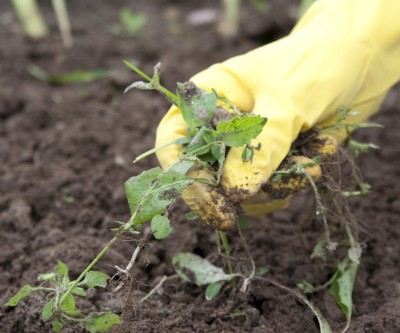Even though the gardening season is coming to an end for most of us, it doesn’t mean that home gardeners aren’t already thinking of next season – and planning ahead.
One of the best ways for the home gardener to eliminate pesky weeds and soil borne pathogens is through a process called soil solarization. It should be noted, though, that the most effective soil solarization takes place in mid-summer when temperatures are at their hottest. Nevertheless, for those in the warmer parts of the U.S., soil solarization may still do some good even into the fall.
What is soil solarization?
Simply put, soil solarization is a way to use the sun’s energy to dramatically heat up the soil. This is done by placing a clear layer of plastic over top of your garden soil. Temperatures under this plastic tarp or sheet can reach as high as 140 degrees F – effectively baking weed seeds, insects, and soil borne pathogens. If you were unfortunate enough to have your garden ravaged by late blight this year, soil solarization will provide some good protection from getting it again next year.
While most sources recommend that soil solarization should be done for four to six weeks, some home gardeners have reported noticeable benefits with only two weeks. Ultimately, a lot depends on how long you are willing to have sections of your garden out of commission.
Steps to Solarization
There are four main steps to soil solarization: cultivating the soil, leveling the soil surface, irrigating the soil, laying the plastic tarp on top of the soil.
Step 1 – Cultivate the soil
The first step is to cultivate or prepare your soil. It is essential that you remove all plant debris as well as rocks and so forth. The purpose of this is not simply to tidy your garden (though it certainly accomplishes that as well), but to actually create conditions in which there is only small, finely textured soil. Doing this will allow the moist air to go deep into the soil where most pathogens will be located.
Step 2 – Level the Soil Surface
Once your soil is free of debris, it is important that the earth you are solarising is as flat as possible. This will help your plastic tarp or cover to stay in place.
Without A Doubt The Best Kept Secret In Indoor Self-Reliance Gardening…
Use a rotary hoe or rototiller to break down large clumps of dirt. Any air pockets caused by debris will only serve to slow the solarization process and prevent your plastic cover from fitting tightly over the soil.
Step 3 – Irrigate the Soil
While it may seem counterintuitive to “water” weed, irrigating your soil is critical to the success of solarization. The reason: When combined with the heat from the sun beating down on the plastic, moisture will make weeds and soil pathogens more vulnerable.
Moisture encourages weed seeds to germinate and soil borne pathogens to become active (as opposed to laying dormant and relatively indestructible until the spring gardening season!). When growth is encouraged, however, these garden pests become vulnerable and can be destroyed by the heat.
To irrigate the soil, it is recommended that you use a drip irrigation line under the tarp.
Step 4 – Plastic Tarp
Once the soil has been cleared of debris, levelled and well-irrigated, you can place the plastic tarp on top of the soil. A clear UV-stabilized plastic should be used, and the thickness should be between 0.5 and 3 mm thick as it must be flexible in order to stretch across the surface and strong enough that it doesn’t tear when birds or other animals come to investigate.
Bury the edges of the sheet 5-6 inches into the soil so that the tarp is not carried away on the first gusty day. You can also weigh the edges down with bricks or other heavy materials. You must make sure however, that the edges are sealed airtight — otherwise your efforts at solarization may be wasted.
Disadvantages of Soil Solarization
While solarization can be a big help for some home gardeners, it is definitely not for everyone. It is most successful in the middle of the summer, which is also peak growing season. This means that unless you have a very large garden, you may not wish to put a big chunk of your garden out of commission for several weeks.
While it can be done in the fall, it is not likely to work without a nice stretch of sunny warm days. In cooler, cloudier areas it may be ineffective.
Benefits of Soil Solarization
Soil solarization is an effective way to manage weeds and other pests. In fact, if you have suffered a particularly bad year for plant diseases, it may be one of the best things that you can do.
An additional benefit is that it may also increase the nutrient availability in your soil. By adding moisture and heat, you will also be breaking down nutrients in the soil, which creates a nutrient-rich liquid – which will be more advantageous to the plants you put in your garden next.
Do you have any soil solarization tips? Leave them in the section below:
 Off The Grid News Better Ideas For Off The Grid Living
Off The Grid News Better Ideas For Off The Grid Living





